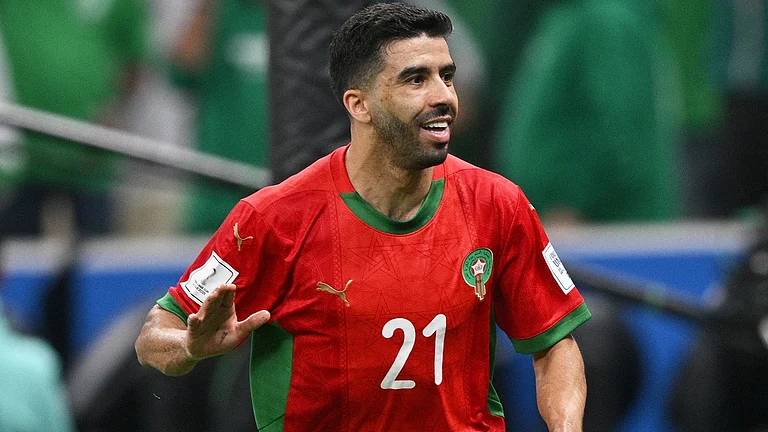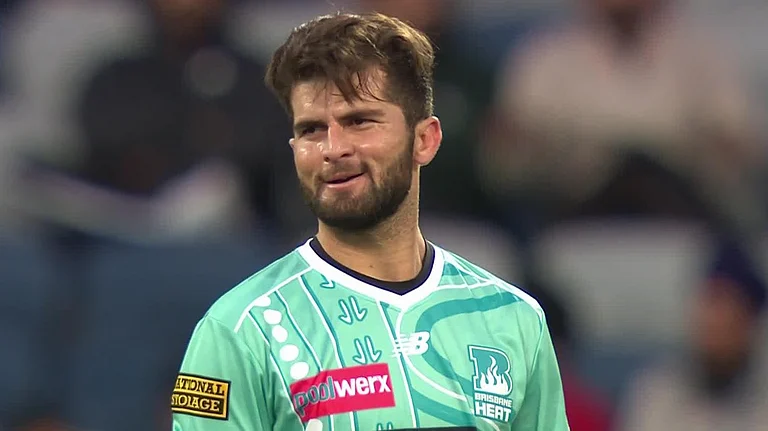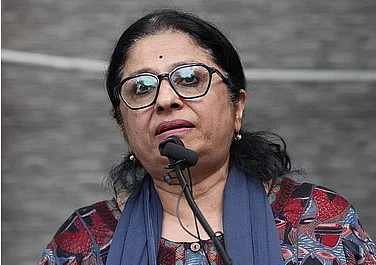The abrogation of Article 370 in Kashmir marked the end of Urdu as the only official language, a status it enjoyed for 131 years. Making any language official is always complex and political in nature. As an official language, Urdu was the symbol of the state’s identity. The short shrift to Urdu in order to make Hindi, Kashmiri, Dogri and English the official languages of the Union Territory will impact its social as well as economic identity.
Urdu was made the official language during Maharaja Pratap Singh’s rule in 1889. Khalid Bashir Ahmad in ‘A Scripted Controversy,’ an essay in his book ‘Kashmir: A Walk Through History’ argues that “Maharaja Pratap Singh introduced Urdu as an official language for Punjabi Hindus because most of his officials were from Punjab”. So, official work was easy and convenient in Urdu. Salim Khan Gami in ‘Kashmir Adab Wa Sakafat’ writes that Urdu was introduced in Kashmir in the sixteenth century. Contradiction this, former VC Kashmir University, a prominent Urdu poet, literary critic and author, Late Hamidi Kashmiri underline in ‘Riyasat Jammu Wa Kashmir Mein Urdu’ that it was introduced in Kashmir in the fifteenth century, when “Kashmiris migrated due to political uncertainty during the end of Zain-ul-Abideen’s rule, to facilitate their trade and to aide them to look for better opportunities.” In ‘Kashmir Mein Urdu,’ Habib Kaifi corroborates it. He further writes: “It was during Sikh rule that Urdu entered Kashmir significantly.”

Urdu was nobody’s first/native language in Kashmir, yet it became the language of the Kashmiri Muslim masses. After Partition, Urdu was made the official language of Kashmir, as per Article 22 of the National Conference’s Naya Kashmir document. It was the medium of education up to the 1990s till Kashmiris became conscious of English as the global language. It is still the medium of education in madrasas or dargahs. It was the language through which three divisions of erstwhile J&K state — Jammu, Kashmir, and Ladakh — communicated. Most books on Islamic history, as well as the texts and translations of the Quran in the Indian subcontinent, are in Urdu. It is the language of Islamic revivalism and pan-Islamic identity in the Indian subcontinent. This is how Urdu got rooted among the Kashmiri masses. Political and historical texts, including the autobiographies of Sheikh Abdullah, Syed Mir Qasim, Amanullah Khan and Syed Ali Geelani, are in Urdu. This speaks volumes about how Urdu is ingrained among the masses here.
Prominent poets of Urdu like Mirza Ghalib, Allama Iqbal, Faiz Ahmad Faiz, Faraz Ahmad, etc were household names in Kashmir. Sheikh Mohammad Abdullah wrote that he changed Muslim Conference to National Conference on Iqbal’s suggestion. This action, on his part, has been brilliantly critiqued by literary figures like Ghulam Nabi Khyal. In his book ‘Iqbal Aur Tehreek-Azaadi-e-Kashmir’ (Iqbal And Freedom Struggle Kashmir), Khyal buttresses his arguments with Iqbal’s speeches, also providing the dates of his last meeting with Iqbal, and contradicting himself. Faiz’s ‘nikah sermon’ was recited by Sheikh Mohammad Abdullah. Faraz was deeply connected with Kashmir and wrote a tribute to his friend and hostel roommate, the Kashmiri leader Maqbool Bhat. This shows how connected Kashmir and Urdu poets were. Urdu Poets used to regularly visit Kashmir. Even during Sheikh Abdullah’s government, Urdu literary figure Rajindra Singh was made the head of the counter-propaganda team. C.M. Naim, in his essay “The Consequences of Indo-Pak War for Urdu Language and Literature: A Parting of the Ways,” writes: “Urdu has been used for propaganda during war or conflict by both India and Pakistan on radio, newspapers etc. Barring Ali Sardar Jafri from India, and Ahmad Nadeem Qasmi and Mukhtar Siddiqui from Pakistan, every other Urdu literary figure was part of propaganda, especially during the 1965 war.”
Johan Galtung, the principal founder of Peace and Conflict Studies, writes in ‘Peace, Violence and Imperialism’ that “language is an important tool of imperialism as the domination of one collectivity over another. It limits the access of other languages to produce knowledge and discourses.” In Kashmir, most literature, including writings on the history of Muslims, are in Urdu. The present ruling class, which looks at Muslims as the ‘other,’ has passed the language order with the same intention that Galtung outlines. It also fits into Edward Said’s argument in his seminal work ‘Orientalism’ that the West created knowledge towards expanding and consolidating the empire. This resonates with Macaulay’s position that Arabic and Sanskrit texts should cease to be published. “A single European library is equal to whole Indian and Arab library,” he had said, revealing the typical Oriental gaze of the East. By stripping Urdu of its official language status, the present ruling regime wants to do the same vis-a-vis Kashmiri Muslims.

An unfortunate thing that has happened is that Urdu has come to be identified with Muslims and Hindi with Hindus. Nagari Pracharini Sabha (Society for the promotion for Nagari) and Hindi Sahitya Samelan (Society for Hindi literature) were formed in Banaras in 1893 and in Allahabad in 1910, respectively, for the promotion of Hindi and Devanagari script. Before these two, Arya Samaj, a Hindu revivalist organisation, was formed in 1875. It too stood for Hindi and Devanagari script. In response to this, Muslims formed Urdu Defence Committee and Anjuman Taraqqi Urdu (Society for the Promotion of Urdu Language) for the protection of Urdu and Persia-Arabic script. English official Gercin De Tessey in 1866 reported about Hindu-Muslim dispute over language. The Hindu (Hindi) activists saw the protection of Hindi as the protection of ancient civilization and culture. Similarly, Muslims saw it as protection of their civilization and culture in South Asia. The Hindu nationalists saw Hindi as the pillar of Hindu identity and the pillar of Indianization. Urdu was perceived as a foreign and de-Indianizing language. Even during the 2002 Gujarat pogrom, Hindu nationalists attacked and demolished the tomb of Wali Dakhani (Wali Gujarati), one of the first poets of Urdu. They attacked it because they saw it as the symbol of Muslim identity.
In South Asian countries like India, Pakistan, Bangladesh and Sri Lanka, language forms group identities. Languages have a huge influence on the politics in South Asia. Pakistan was separated from British India on the basis of the language (Urdu). Bangladesh, too, was separated from Pakistan in 1971 on the basis of language (Bangla). Jyotirindra Das Gupta, in ‘Language Conflict and National Development,’ writes that the “Muslim league and Aligarh Movement identified Urdu as the symbol of Muslim separatism”. In ‘Language and Politics in North India,’ Paul R. Brass argues how British Indian Muslims manipulated Urdu for their own politics, a claim which Francis Robinson substantiated in his work. Political Scientist Christophe Jaffrelot writes in ‘Pakistan Paradox’ that the creation of Pakistan and the Partition of British India had its basis on the Urdu language. It was over Urdu’s script that Sir Syed Ahmad Khan had said, “Hindus and Muslims can’t live together.” In ‘Hayat-I-Javed,’ Sir Syed’s biographer and prominent Urdu literary figure Altaf Hussain Hali writes, “…Baba Shiv Prasad wrote a memorandum that Persian and Urdu is half-Arabic. It is semitic and cannot blossom in the land of Hindus and Aryans.”
The pre-Partition Indian Muslim Political party, too, had passed a resolution for its protection in 1904, 1909, 1910, 1917, and 1926. They used Urdu as a key symbol in constructing a sense of unity among Muslims. It is not only Muslims who used Urdu, but Hindus also used Hindi for their politics. In ‘Gita Press and the Making of Hindu India,’ Akshaya Mukul writes how Gita Press, especially its Hindi journal ‘Kalyan,’ used to construct the idea of a Hindu nation, and every politician from Mahatma Gandhi to Madan Mohan Malaviya wrote for it.” Gandhi, too, mobilized people for his politics by using Hindi. Initially, he had supported vernaculars as they were makers of indigenous identity. But later, he also supported Hindi by calling Hindustani, Hindi Hindustani. When Urdu was under constant attack, many

When Partition became a reality, most Hindus took revenge on Urdu against the creation of Pakistan as it was its national language. Many members of the constituent assembly spoke in favour of deleting Urdu from the draft Constitution. In most secular and other educational institutes and universities, no Urdu was taught. Prominent Urdu literary critic Shamsur Rahman Faruqi even spoke against unfair budget allocation to government Urdu organisations. Not only this, different governments used these organisations for their own agenda in an institutionalised way, leaving the promotion of Urdu aside.
In Kashmir, too, there was controversy over the script in 1940 when N. Gopalaswami Ayyangar was the Prime Minister. There were protests when he had tried to introduce the Devanagari script. National Conference members of Praja Sabha (Assembly) resigned in protest. Despite these protests, however, its tallest leader Sheikh Mohammad Abdullah said in Jammu in 1942: “We are with Congress (Nehru) on this issue; if they say Sanskrit is our language, we accept it.” Congress was in favour of the Devanagari script at that time. Progressive leaders, like Prem Nath Bazaz, were in favour of this, thus siding with the government. The top religious cleric Mirwaiz Yusuf Shah said: “We know what is coming” and protested against it on Muslim identity. During this time, Maulvi Abdul Haq, known as Baba-e-Urdu (Father of Urdu), realising the apathy towards Urdu in Kashmir, inaugurated a branch of Anjuman-e Taraqqi-e Urdu in Jammu for its protection and promotion. The issue died down due to the geopolitics surrounding the Second World War and the British Policy towards princely states.
After Partition, Urdu was made the official language of Kashmir as per section 145, recognised by the Eighth Schedule. In the decades that followed, Urdu started to slowly disappear. From public offices to government departments’ official boards, Urdu came to be replaced by English. Speaking Urdu was seen as prestige and gave social mobility to people, but it was replaced by English. Even the Urdu works of pioneers of Modern Kashmiri poetry like Mahjoor and Azad, have been replaced by works in English. Till the 1990s, most newspapers were in Urdu, including ‘Bidya Bilas,’ Kashmir’s first newspaper. But now everything has decelerated from Urdu to English. In 1982, legislator Ghulam Ahmad Shah spoke about the apathy towards Urdu. He suffered a heart attack while speaking and died in the hospital. What Mirwaiz Yusuf Shah saw as coming during the 1940s and what Ghulam Ahamd Shah spoke about in 1982 came true in 2019, with the abrogation of Article 370.
Persian was replaced by Urdu as the official language of Kashmir in 1889. A lot of Kashmir’s legacy is embedded in Persian. Allama Rashidi writes in ‘Tazkira-e-Shora-e-Kashmir:’ “Kashmir produced 1,678 Persian poets” and thousands of manuscripts are in Persian. However, very few poets, diwans or manuscripts are available. It seems that the same fate can also happen to Urdu in Kashmir if natives won’t teach their kids to write and read the language. They need to preserve manuscripts in Urdu. They should remember that the ‘erosion of Urdu also means the erosion of assimilating identity, cultural and political traditions associated with Muslims’.”
(Faizaan Bhat teaches in the Department of Lifelong Learning, Kashmir University. He writes on South Asian Politics and History.)





















